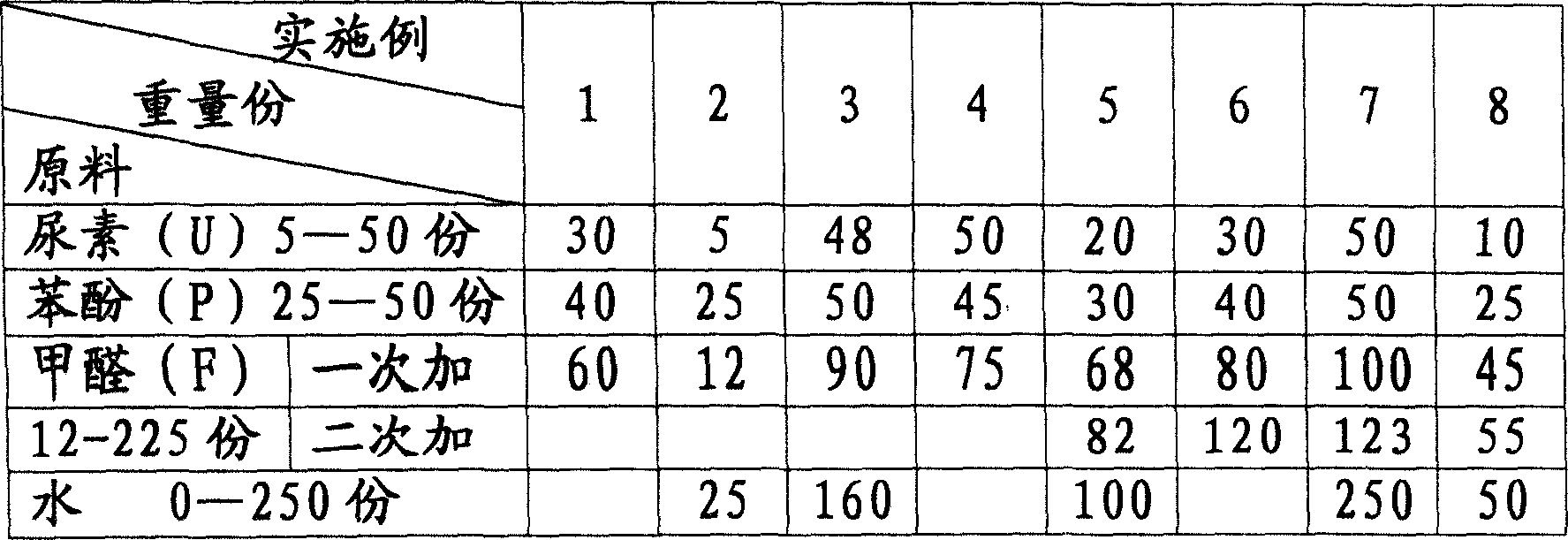Urea-phenol-formaldehyde co-condensation polymer resin and its production process
A technology of co-condensation resin and phenol-formaldehyde, which is applied in the field of urea-phenol-formaldehyde co-condensation resin and its production, can solve the problems affecting resin bonding strength, stability, storage period, and insufficient co-condensation reaction, etc., and achieve cost Low, high bonding strength, sufficient co-condensation reaction effect
- Summary
- Abstract
- Description
- Claims
- Application Information
AI Technical Summary
Problems solved by technology
Method used
Image
Examples
Embodiment 1
[0010] Embodiment 1 (referring to serial number and the proportioning figure of parts by weight in the table):
[0011] First melt 40 parts of phenol (P) in the reactor, add 60 parts of formaldehyde (F), 30 parts of urea (U), without adding water, adjust the pH to 6-8, raise the temperature to 75-100°C, and keep it warm for 30-100min , and then use ammonium chloride to adjust PH=3.0-5.5, and carry out co-condensation reaction. When the viscosity is ≥20S (20°C, apply 4 cups), use NaoH to adjust PH=7.5-12.0, control the temperature at 80-95°C, and keep warm for the reaction To the end, cooling and discharging.
Embodiment 2
[0013] Melt 25 parts of P in the reactor, then add 5 parts of U, 12 parts of F, and 25 parts of water, and obtain this resin in the same way as in Example 1.
[0014] Embodiment 3 and 4 are all according to the proportioning in the table, and the method with reference to embodiment 1, 2 makes this resin. Embodiment 1-4, molar ratio F: (P+U)≤1.3, F adds once.
Embodiment 5
[0016] Melt 30 parts of P in the reactor, then add 20 parts of U, design the total amount of F to be 150 parts, add 68 parts of F for the first time, adjust the pH to 6-8, raise the temperature to 75-100°C, keep it warm for 30-100min, and use hydrochloric acid Adjust PH=3.0-5.5, carry out co-condensation reaction, when the viscosity is ≥20S (20°C, apply 4 cups), use Naco 3 , adjust the pH to 7.5-12.0, add 100 parts of water, add the remaining F82 parts twice, control the temperature at 80-95°C, keep the reaction until the end, and cool and discharge.
PUM
 Login to View More
Login to View More Abstract
Description
Claims
Application Information
 Login to View More
Login to View More - R&D
- Intellectual Property
- Life Sciences
- Materials
- Tech Scout
- Unparalleled Data Quality
- Higher Quality Content
- 60% Fewer Hallucinations
Browse by: Latest US Patents, China's latest patents, Technical Efficacy Thesaurus, Application Domain, Technology Topic, Popular Technical Reports.
© 2025 PatSnap. All rights reserved.Legal|Privacy policy|Modern Slavery Act Transparency Statement|Sitemap|About US| Contact US: help@patsnap.com

